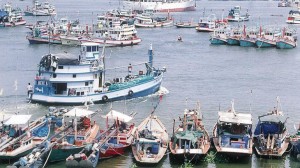Highlights of Thailand’s Marine Fisheries Management Plan, 2015-2019
Highlights of Thailand’s Marine Fisheries Management Plan, 2015-2019
วันที่นำเข้าข้อมูล 21 Jan 2016
วันที่ปรับปรุงข้อมูล 29 Nov 2022
The Council of Ministers approved, on 3rd November 2015, Thailand’s Marine Fisheries Management Plan (FMP) for 2015-2019.
The FMP identifies two pressing threats to the sustainable management of fisheries resources: (1) overfishing and overcapacity of the fishing fleet and (2) IUU fishing. It also outlines other challenges, including catching of large quantities of juvenile fish, conflicts between artisanal and commercial fishers, degradation of critical fish habitats, and inadequate fisheries data and management capacity.
The FMP’s principal goals are to:
- reform Thailand’s marine fisheries from an open access regime into a limited access regime where the fishing effort is commensurate with the maximum sustainable yield (MSY);
- prevent, deter and eliminate IUU fishing;
- increase benefits for and reduce conflicts among major stakeholders;
- improve the marine environment; and
- strengthen capacity to sustainably manage the fisheries.
The FMP aims to reduce the fishing capacity and fishing effort to limit the catch at or near the MSY. The specific capacity reduction targets are (i) for demersal fish, 40% in the Gulf of Thailand and 10% in the Andaman Sea and (ii) for pelagic fish, 30% in the Gulf of Thailand and 20% in the Andaman Sea. The main measures to achieve these targets are the removal of currently illegal commercial fishing vessels, plus a series of temporal closures to remove any excess fishing effort. Compensation incentives will be used, as well as buy-back scheme.
The FMP is also designed to deter and curtail IUU fishing to a level that can be controlled through regular monitoring, control and surveillance (MCS) arrangements in the future. Fishing vessel registration and licensing systems are to be improved, so as to establish a complete and accurate dabatase of fishing vessels and to prevent vessels with a history of IUU fishing from being registered. The Thai Government commits to allocate financial, technical and human resources required to enhance Thailand’s MCS capacity and ensure effective implementation of the FMP.
Other aspects of overfishing and IUU fishing are being managed through a number relavant measures. The high catch of juveniles of commercial species is being managed through mesh size limitations and spatial and temporal closures. Conflicts between sub-sectors are being managed through declaration of exclusive fishing rights to different zones (distance from the coast). Critical habitats will be restored through increased collaboration and cooperation with other agencies mandated to protect and conserve the marine environment.
The FMP also recognizes the importance of better data and information to inform management decision making and proposes several important changes on research, data and information that can be used in the management of Thai fisheries.
The FMP details all management measures needed to meet its objectives as well as key performance indicators and timelines. It also specifies how the measures are to be implemented in a work plan for implementation 2015/16.
The FMP will be reviewed every year with a progress report against the objectives. A major evaluation and review of this plan will be carried out every two years, and if appropriate, the issues, goals and objectives will be modified.
*************
European Union Division
Department of European Affairs
18 November 2015
- Source: http://www2.thaiembassy.be/highlights-of-thailands-marine-fisheries-management-plan-2015-2019/
สถานเอกอัครราชทูต ณ กรุงโคเปนเฮเกน
Office Hours: Monday - Friday, 09:00 - 11:45 hrs. and 13:00 - 15:45 hrs. (Except public holidays)
